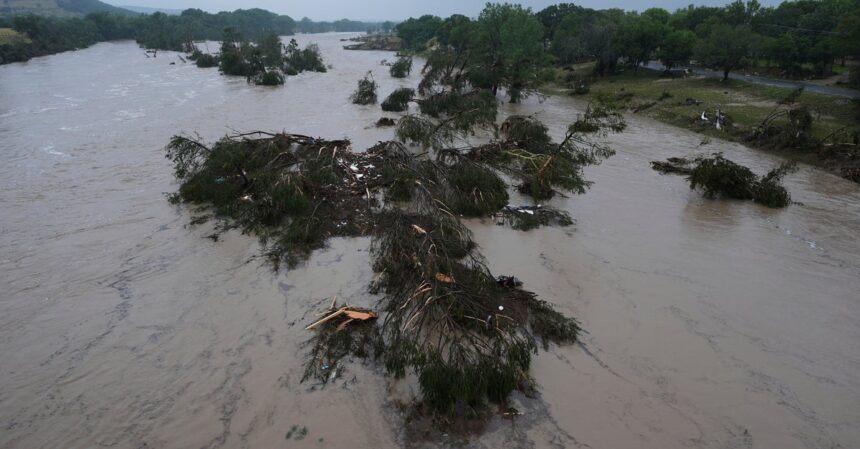The devastating floods in Texas Hill Country have left a trail of destruction and heartache. The heavy rain that fell in a matter of hours has claimed the lives of 24 people, with many more still missing. Among the missing are 20 girls attending a summer camp in the small town of Hunt.
Desperate pleas for information have flooded social media as loved ones seek any information about those caught in the flood zone. The flash flooding of the Guadalupe River has caused chaos and destruction in its wake. The situation is dire, with 237 people rescued so far, including 167 by helicopter.
The missing children from Camp Mystic, a Christian camp along the Guadalupe River, have sparked a massive search and rescue operation. Elinor Lester, a 13-year-old camper, described the harrowing experience of being airlifted to safety as the floodwaters rose around them.
The death toll is expected to rise as rescue operations continue for the remaining missing individuals. Authorities are working tirelessly to identify the deceased and reunite families with their loved ones.
The rapid rise of the river caught many residents by surprise, with a river gauge recording a 22-foot rise in just two hours. The sheer force of the floodwaters has left a path of destruction in its wake, with homes and businesses destroyed.
Residents like Erin Burgess and Matthew Stone have recounted their terrifying experiences of being caught in the floodwaters. Burgess and her family clung to a tree for hours, waiting for the waters to recede, while Stone described the flood as a “pitch black wall of death.”
The community has come together in the face of this tragedy, with hundreds of volunteers and emergency responders working tirelessly to rescue those in need. The road to recovery will be long and difficult, but the resilience and strength of the community will see them through this dark time. A man and a group of rescuers thought they heard someone yelling “help!” from the water, but they couldn’t see anyone, according to his account. The situation was tense as they tried to locate the source of the cries for help.
At a reunification center set up in Ingram, emotions ran high as families were reunited with their loved ones who had been rescued. There were tears of joy and relief as people disembarked from vehicles filled with evacuees. Two soldiers even carried an elderly woman who was unable to climb down a ladder to safety. Amidst the chaos, a woman clung to her small white dog, showing the bond between humans and their pets during times of crisis.
Barry Adelman, a survivor of the flood, shared his harrowing experience of being trapped in his three-story house with his 94-year-old grandmother and 9-year-old grandson. The water rose so high that it pushed them into the attic, leaving them stranded until the waters finally receded. Adelman expressed his fear and horror at having to reassure his grandson while feeling scared to death himself.
The forecast had predicted rain and issued a flood warning for the area, but the extent of the flooding exceeded expectations. The potential for heavy rain and flooding covered a large area, catching many residents off guard. Judge Rob Kelly, the county’s chief elected official, admitted that there was no warning system in place to alert people to the impending disaster. The community was unprepared for the magnitude of the flood, with Kelly acknowledging that no one knew such a catastrophic event was on the horizon.
The area where the flooding occurred is known as “flash flood alley” due to the hilly terrain and thin soil that causes water to rush downhill during heavy rains. The region is a popular tourism destination, with river homes, cabins for rent, and century-old summer camps attracting visitors from all over the country. The tranquil Guadalupe River, with its clear blue waters, has been a draw for generations of tourists seeking relaxation and recreation.
As severe weather moved through central New Jersey, thunderstorms claimed at least three lives, including two men in Plainfield who were killed when a tree fell on their vehicle. The city of Plainfield canceled its July Fourth celebrations, including the parade, concert, and fireworks show, in response to the tragic deaths.
The devastating floods in Texas and the deadly thunderstorms in New Jersey serve as stark reminders of the unpredictable and destructive power of nature. In times of crisis, communities come together to support one another and rebuild in the face of adversity. Memphis, Tennessee, Salt Lake City, Springfield, Illinois, and Norwich, Connecticut – In a collaborative effort, Associated Press reporters from various locations across the United States have come together to shed light on important issues affecting their respective communities.
In Memphis, Tennessee, reporter Adrian Sanz has been diligently covering the impact of recent budget cuts on local schools. As funding continues to decrease, teachers and students alike are feeling the strain of limited resources. Sanz has been speaking with educators and parents to understand the challenges they are facing and the potential solutions that could help alleviate the burden on the education system.
Meanwhile, in Salt Lake City, reporter Hannah Schoenbaum has been investigating the rise in homelessness in the area. With housing prices skyrocketing and affordable options becoming scarce, more and more individuals and families are finding themselves without a place to call home. Schoenbaum has been speaking with advocates and community leaders to explore possible solutions to this growing crisis.
In Springfield, Illinois, reporter John O’Connor has been closely following the debate over gun control legislation in the state. With a rise in gun violence plaguing many communities, lawmakers are under pressure to enact stricter laws to prevent further tragedies. O’Connor has been speaking with politicians and advocates on both sides of the issue to provide a comprehensive look at the ongoing discussions.
Lastly, in Norwich, Connecticut, reporter Susan Haigh has been reporting on the impact of climate change on the local environment. From rising sea levels to extreme weather events, the effects of climate change are becoming increasingly apparent in the region. Haigh has been speaking with scientists and environmentalists to highlight the urgent need for action to protect the planet for future generations.
Through their dedicated reporting and in-depth analysis, these Associated Press reporters are working to shine a light on the most pressing issues facing their communities. By bringing these stories to the forefront, they hope to inspire change and create a better future for all. The impact of social media on mental health
Social media has become an integral part of our daily lives, connecting us with friends and family, providing a platform for self-expression, and keeping us informed about current events. However, the rise of social media has also raised concerns about its impact on mental health.
One of the ways in which social media can negatively affect mental health is through the constant comparison to others. Social media platforms such as Instagram and Facebook often create an environment where users feel pressured to present a perfect version of themselves, leading to feelings of inadequacy and low self-esteem. Seeing friends and influencers post glamorous vacation photos or perfectly curated meals can make individuals feel like they are not measuring up, leading to feelings of envy and depression.
Another way in which social media can impact mental health is through cyberbullying. The anonymity provided by the internet can embolden individuals to engage in hurtful behavior, leading to harassment and abuse. Cyberbullying can have serious consequences on the mental health of its victims, leading to feelings of isolation, anxiety, and depression.
The constant connectedness facilitated by social media can also have a negative impact on mental health. The constant notifications and updates can lead to feelings of overwhelm and anxiety, making it difficult for individuals to disconnect and relax. Studies have shown that excessive use of social media can lead to poor sleep quality, increased stress levels, and decreased overall well-being.
Despite these negative effects, social media also has the potential to have a positive impact on mental health. Platforms such as Twitter and Facebook can provide a sense of community and support for individuals facing mental health challenges. Online support groups and mental health resources can connect individuals with others who are going through similar experiences, providing a sense of belonging and understanding.
To mitigate the negative effects of social media on mental health, it is important for individuals to be mindful of their social media usage. Setting boundaries around social media use, such as limiting screen time or taking breaks from social media, can help reduce feelings of overwhelm and anxiety. It is also important for individuals to curate their social media feeds, following accounts that promote positivity and self-acceptance.
In conclusion, social media has the potential to both positively and negatively impact mental health. By being mindful of their social media usage and setting boundaries around their online activity, individuals can mitigate the negative effects of social media on their mental health and create a more positive and healthy online experience. The Importance of Mental Health in Today’s Society
Mental health is a topic that is often overlooked in today’s fast-paced society. With the pressures of work, school, and social media, many individuals neglect their mental well-being, leading to a variety of mental health issues such as anxiety, depression, and stress. It is crucial to prioritize mental health in order to lead a happy and fulfilling life.
One of the main reasons why mental health is so important is because it directly impacts our overall well-being. When our mental health is suffering, it can affect every aspect of our lives, from our relationships with others to our performance at work or school. Taking care of our mental health is essential for maintaining a healthy and balanced life.
In addition, mental health plays a significant role in our physical health as well. Studies have shown that individuals who suffer from mental health issues are more likely to have chronic illnesses such as heart disease, diabetes, and obesity. This is because mental health issues can weaken our immune system and make us more susceptible to physical ailments. By prioritizing our mental health, we can improve our physical health and overall quality of life.
Furthermore, mental health is crucial for building resilience and coping with life’s challenges. When we take care of our mental well-being, we are better equipped to handle stress, setbacks, and disappointments. We are more resilient and able to bounce back from difficult situations. This resilience is key to navigating the ups and downs of life and maintaining a positive outlook.
It is important to destigmatize mental health and encourage open conversations about it. Many individuals feel ashamed or embarrassed to seek help for their mental health issues, which only perpetuates the problem. By promoting mental health awareness and providing resources for support, we can create a more compassionate and understanding society that values mental well-being.
In conclusion, mental health is a vital component of our overall health and well-being. It is essential to prioritize mental health in order to lead a happy and fulfilling life, improve our physical health, build resilience, and cope with life’s challenges. By destigmatizing mental health and promoting open conversations about it, we can create a society that values and supports mental well-being.








